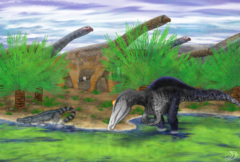| Sao Khua Formation | |
|---|---|
| Stratigraphic range: late Valanginian-early Hauterivian ~ | |
 Restoration of Siamosaurus, Sunosuchus and Phuwiangosaurus in the Sao Khua Formation palaeoenvironment. | |
| Type | Geological formation |
| Unit of | Khorat Group |
| Underlies | Phu Phan Formation |
| Overlies | Phra Wihan Formation |
| Thickness | ~120 m (390 ft) |
| Lithology | |
| Primary | Sandstone, conglomerate |
| Other | Siltstone, claystone |
| Location | |
| Coordinates | 16°42′N 102°18′E / 16.7°N 102.3°E |
| Approximate paleocoordinates | 14°18′N 112°24′E / 14.3°N 112.4°E |
| Region | Indochina |
| Country | |
| Extent | Khorat Plateau |
| Type section | |
| Named by | Ward & Bunnag |
| Year defined | 1964 |
The Sao Khua Formation (Thai: หมวดหินเสาขัว) is a middle member of the Khorat Group. It consists of an alteration of pale red to yellowish-gray, fine to medium-grained sandstone and grayish-reddish brown siltstone and clay. Rare pale red to light gray conglomerates, containing carbonate pebbles, are also characteristic of this formation. This geological formation in Thailand dates to the Early Cretaceous age, specifically the Valanginian through Hauterivian stages.[1]
Dinosaur remains are among the fossils that have been recovered from the formation.[2]
- ^ Tucker, Ryan T.; Hyland, Ethan G.; Gates, Terry A.; King, M. Ryan; Roberts, Eric M.; Foley, Elliot K.; Berndt, David; Hanta, Rattanaphorn; Khansubha, Sasa-on; Aswasereelert, Wasinee; Zanno, Lindsay E. (September 2022). "Age, depositional history, and paleoclimatic setting of Early Cretaceous dinosaur assemblages from the Sao Khua Formation (Khorat Group), Thailand". Palaeogeography, Palaeoclimatology, Palaeoecology. 601: 111107. Bibcode:2022PPP...60111107T. doi:10.1016/j.palaeo.2022.111107. ISSN 0031-0182. S2CID 249702713.
- ^ Weishampel, David B; et al. (2004). "Dinosaur distribution (Early Cretaceous, Asia)." In: Weishampel, David B.; Dodson, Peter; and Osmólska, Halszka (eds.): The Dinosauria, 2nd, Berkeley: University of California Press. Pp. 563-570. ISBN 0-520-24209-2.
